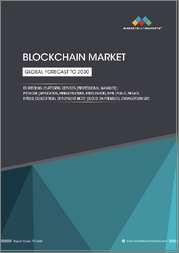
|
시장보고서
상품코드
1673771
미들웨어 시장 규모, 점유율, 성장 분석 : 유형별, 배포별, 지역별 - 산업 예측(2025-2032년)Middleware Market Size, Share, and Growth Analysis, By Type (Integration Middleware, Platform Middleware), By Deployment (On-premise, Cloud-based.), By Region - Industry Forecast 2025-2032 |
||||||
세계의 미들웨어 시장 규모는 2023년에 338억 달러에 달하며, 예측 기간(2025-2032년)의 CAGR은 10.8%로, 2024년 374억 5,000만 달러에서 2032년에는 850억 7,000만 달러로 성장할 전망입니다.
세계의 미들웨어 시장은 디지털 전환에 있으며, 원활한 통합과 효율적인 데이터 교환의 필요성을 인식하는 기업이 증가함에 따라 강력한 성장세를 보이고 있습니다. 기업이 다양한 기술과 용도를 활용함에 따라 미들웨어는 이러한 시스템을 연결하고 통합하여 다양한 IT 환경의 복잡성을 단순화하는 데 필수적인 역할을 하고 있으며, SaaS, PaaS, IaaS를 포함한 클라우드 컴퓨팅 서비스의 부상으로 온프레미스 및 클라우드 인프라를 통합하는 데 있으며, 온프레미스와 클라우드 인프라를 효과적으로 연결하는 미들웨어 솔루션에 대한 수요가 증가하고 있습니다. 이러한 통합 기능을 통해 기업은 클라우드 기반 용도를 레거시 시스템과 연동하고, 데이터 흐름을 촉진하며, IoT 및 AI와 같은 혁신적인 기술의 채택을 촉진할 수 있습니다. 궁극적으로 미들웨어는 빠르게 진화하는 디지털 환경에서 민첩성과 경쟁력을 강화하고자 하는 조직에게 매우 중요한 역할을 합니다.
목차
서론
- 조사의 목적
- 조사 범위
- 정의
조사 방법
- 정보 조달
- 2차와 1차 데이터 방법
- 시장 규모 예측
- 시장의 전제조건과 제한
개요
- 세계 시장 전망
- 공급과 수요 동향 분석
- 부문별 기회 분석
시장 역학과 전망
- 시장 개요
- 시장 규모
- 시장 역학
- 촉진요인과 기회
- 억제요인과 과제
- Porter의 산업 분석
주요 시장 인사이트
- 주요 성공 요인
- 경쟁의 정도
- 주요 투자 기회
- 시장 에코시스템
- 시장의 매력 지수(2024년)
- PESTEL 분석
- 거시경제 지표
- 밸류체인 분석
- 가격 분석
미들웨어 시장 규모 : 유형별 & CAGR(2025-2032)
- 시장 개요
- 통합 미들웨어
- 플랫폼 미들웨어
미들웨어 시장 규모 : 배포별 & CAGR(2025-2032)
- 시장 개요
- 온프레미스
- 클라우드 기반
미들웨어 시장 규모 & CAGR(2025-2032)
- 북미
- 미국
- 캐나다
- 유럽
- 독일
- 스페인
- 프랑스
- 영국
- 이탈리아
- 기타 유럽 지역
- 아시아태평양
- 중국
- 인도
- 일본
- 한국
- 기타 아시아태평양
- 라틴아메리카
- 브라질
- 기타 라틴아메리카 지역
- 중동 및 아프리카
- GCC 국가
- 남아프리카공화국
- 기타 중동 및 아프리카
경쟁 정보
- 상위 5사의 비교
- 주요 기업의 시장 포지셔닝(2024년)
- 주요 시장 기업이 채택한 전략
- 최근 시장 동향
- 기업의 시장 점유율 분석(2024년)
- 주요 기업의 기업 개요
- 기업의 상세
- 제품 포트폴리오 분석
- 기업의 부문별 점유율 분석
- 매출의 전년대비 비교(2022-2024)
주요 기업 개요
- IBM(USA)
- Oracle(USA)
- Microsoft(USA)
- SAP(Germany)
- TIBCO Software(USA)
- Software AG(Germany)
- MuleSoft(Salesforce)(USA)
- Progress Software(USA)
- Apache Software Foundation(USA)
- Amazon Web Services(AWS)(USA)
- Google Cloud Platform(GCP)(USA)
- Azure(Microsoft)(USA)
- Dell Technologies(USA)
- Fujitsu(Japan)
- Hitachi Vantara(Japan)
- Informatica(USA)
- OpenText(Canada)
결론과 제안
KSA 25.04.16Global Middleware Market size was valued at USD 33.8 billion in 2023 and is poised to grow from USD 37.45 billion in 2024 to USD 85.07 billion by 2032, growing at a CAGR of 10.8% during the forecast period (2025-2032).
The global middleware market is experiencing robust growth as businesses increasingly recognize the necessity of seamless integration and efficient data exchange in their digital transformation efforts. As companies utilize diverse technologies and applications, middleware becomes essential for connecting and integrating these systems, simplifying the complexity of varied IT environments. The rise of cloud computing services-including SaaS, PaaS, and IaaS-has escalated the demand for middleware solutions that effectively bridge on-premises and cloud infrastructures. This integration capability allows organizations to align cloud-based applications with legacy systems, fostering data flow and facilitating the adoption of innovative technologies like IoT and AI. Ultimately, middleware is pivotal for organizations striving to enhance agility and competitiveness in a rapidly evolving digital landscape.
Top-down and bottom-up approaches were used to estimate and validate the size of the Global Middleware market and to estimate the size of various other dependent submarkets. The research methodology used to estimate the market size includes the following details: The key players in the market were identified through secondary research, and their market shares in the respective regions were determined through primary and secondary research. This entire procedure includes the study of the annual and financial reports of the top market players and extensive interviews for key insights from industry leaders such as CEOs, VPs, directors, and marketing executives. All percentage shares split, and breakdowns were determined using secondary sources and verified through Primary sources. All possible parameters that affect the markets covered in this research study have been accounted for, viewed in extensive detail, verified through primary research, and analyzed to get the final quantitative and qualitative data.
Global Middleware Market Segments Analysis
Global Middleware Market is segmented by Type, Deployment and region. Based on Type, the market is segmented into Integration Middleware and Platform Middleware. Based on Deployment, the market is segmented into On-premise and Cloud-based.. Based on region, the market is segmented into North America, Europe, Asia Pacific, Latin America and Middle East & Africa.
Driver of the Global Middleware Market
A significant factor propelling the expansion of the global middleware market is the rising adoption of cloud-based technologies. As organizations increasingly transition their operations to the cloud, the demand for middleware solutions that streamline the integration of various software systems and applications is growing. Cloud-based middleware offers numerous benefits, such as enhanced scalability, greater flexibility, and cost efficiency. Furthermore, these solutions allow businesses to access their data and applications from virtually any location, facilitating collaboration among remote teams and workforces. This ongoing trend towards cloud computing is projected to further stimulate the growth of the middleware market in the foreseeable future.
Restraints in the Global Middleware Market
A significant restraint in the Global Middleware market is the inherent complexity involved in integrating diverse software systems and applications. As organizations increasingly utilize various technologies, platforms, and programming languages, establishing seamless data exchange becomes difficult. Middleware solutions need to navigate these complexities while maintaining robust data security and adhering to industry regulations. Furthermore, the deployment of middleware can be both time-intensive and expensive, necessitating considerable investments in IT infrastructure and skilled personnel. These challenges can hinder the adoption of middleware, especially for smaller enterprises that often face resource limitations and lack the capacity to manage such sophisticated solutions.
Market Trends of the Global Middleware Market
The global middleware market is experiencing significant growth, driven primarily by the increasing adoption of microservices architecture. This modular approach to software development allows organizations to decompose intricate applications into smaller, independently deployable services, enhancing agility, scalability, and resilience. As businesses seek to accelerate their digital transformation efforts, the flexibility of microservices-enabling diverse programming languages and frameworks-greatly boosts development speed and efficiency. This trend not only supports rapid innovation but also facilitates smoother integration of applications and services across various platforms. As more organizations embrace this architectural paradigm, the middleware market is poised for robust expansion in the forthcoming years.
Table of Contents
Introduction
- Objectives of the Study
- Scope of the Report
- Definitions
Research Methodology
- Information Procurement
- Secondary & Primary Data Methods
- Market Size Estimation
- Market Assumptions & Limitations
Executive Summary
- Global Market Outlook
- Supply & Demand Trend Analysis
- Segmental Opportunity Analysis
Market Dynamics & Outlook
- Market Overview
- Market Size
- Market Dynamics
- Drivers & Opportunities
- Restraints & Challenges
- Porters Analysis
- Competitive rivalry
- Threat of substitute
- Bargaining power of buyers
- Threat of new entrants
- Bargaining power of suppliers
Key Market Insights
- Key Success Factors
- Degree of Competition
- Top Investment Pockets
- Market Ecosystem
- Market Attractiveness Index, 2024
- PESTEL Analysis
- Macro-Economic Indicators
- Value Chain Analysis
- Pricing Analysis
Global Middleware Market Size by Type & CAGR (2025-2032)
- Market Overview
- Integration Middleware
- Platform Middleware
Global Middleware Market Size by Deployment & CAGR (2025-2032)
- Market Overview
- On-premise
- Cloud-based.
Global Middleware Market Size & CAGR (2025-2032)
- North America (Type, Deployment)
- US
- Canada
- Europe (Type, Deployment)
- Germany
- Spain
- France
- UK
- Italy
- Rest of Europe
- Asia Pacific (Type, Deployment)
- China
- India
- Japan
- South Korea
- Rest of Asia-Pacific
- Latin America (Type, Deployment)
- Brazil
- Rest of Latin America
- Middle East & Africa (Type, Deployment)
- GCC Countries
- South Africa
- Rest of Middle East & Africa
Competitive Intelligence
- Top 5 Player Comparison
- Market Positioning of Key Players, 2024
- Strategies Adopted by Key Market Players
- Recent Developments in the Market
- Company Market Share Analysis, 2024
- Company Profiles of All Key Players
- Company Details
- Product Portfolio Analysis
- Company's Segmental Share Analysis
- Revenue Y-O-Y Comparison (2022-2024)
Key Company Profiles
- IBM (USA)
- Company Overview
- Business Segment Overview
- Financial Updates
- Key Developments
- Oracle (USA)
- Company Overview
- Business Segment Overview
- Financial Updates
- Key Developments
- Microsoft (USA)
- Company Overview
- Business Segment Overview
- Financial Updates
- Key Developments
- SAP (Germany)
- Company Overview
- Business Segment Overview
- Financial Updates
- Key Developments
- TIBCO Software (USA)
- Company Overview
- Business Segment Overview
- Financial Updates
- Key Developments
- Software AG (Germany)
- Company Overview
- Business Segment Overview
- Financial Updates
- Key Developments
- MuleSoft (Salesforce) (USA)
- Company Overview
- Business Segment Overview
- Financial Updates
- Key Developments
- Progress Software (USA)
- Company Overview
- Business Segment Overview
- Financial Updates
- Key Developments
- Apache Software Foundation (USA)
- Company Overview
- Business Segment Overview
- Financial Updates
- Key Developments
- Amazon Web Services (AWS) (USA)
- Company Overview
- Business Segment Overview
- Financial Updates
- Key Developments
- Google Cloud Platform (GCP) (USA)
- Company Overview
- Business Segment Overview
- Financial Updates
- Key Developments
- Azure (Microsoft) (USA)
- Company Overview
- Business Segment Overview
- Financial Updates
- Key Developments
- Dell Technologies (USA)
- Company Overview
- Business Segment Overview
- Financial Updates
- Key Developments
- Fujitsu (Japan)
- Company Overview
- Business Segment Overview
- Financial Updates
- Key Developments
- Hitachi Vantara (Japan)
- Company Overview
- Business Segment Overview
- Financial Updates
- Key Developments
- Informatica (USA)
- Company Overview
- Business Segment Overview
- Financial Updates
- Key Developments
- OpenText (Canada)
- Company Overview
- Business Segment Overview
- Financial Updates
- Key Developments



















